TOYOTA TACOMA 2010 Owners Manual (in English)
Manufacturer: TOYOTA, Model Year: 2010, Model line: TACOMA, Model: TOYOTA TACOMA 2010Pages: 532, PDF Size: 15.03 MB
Page 211 of 532
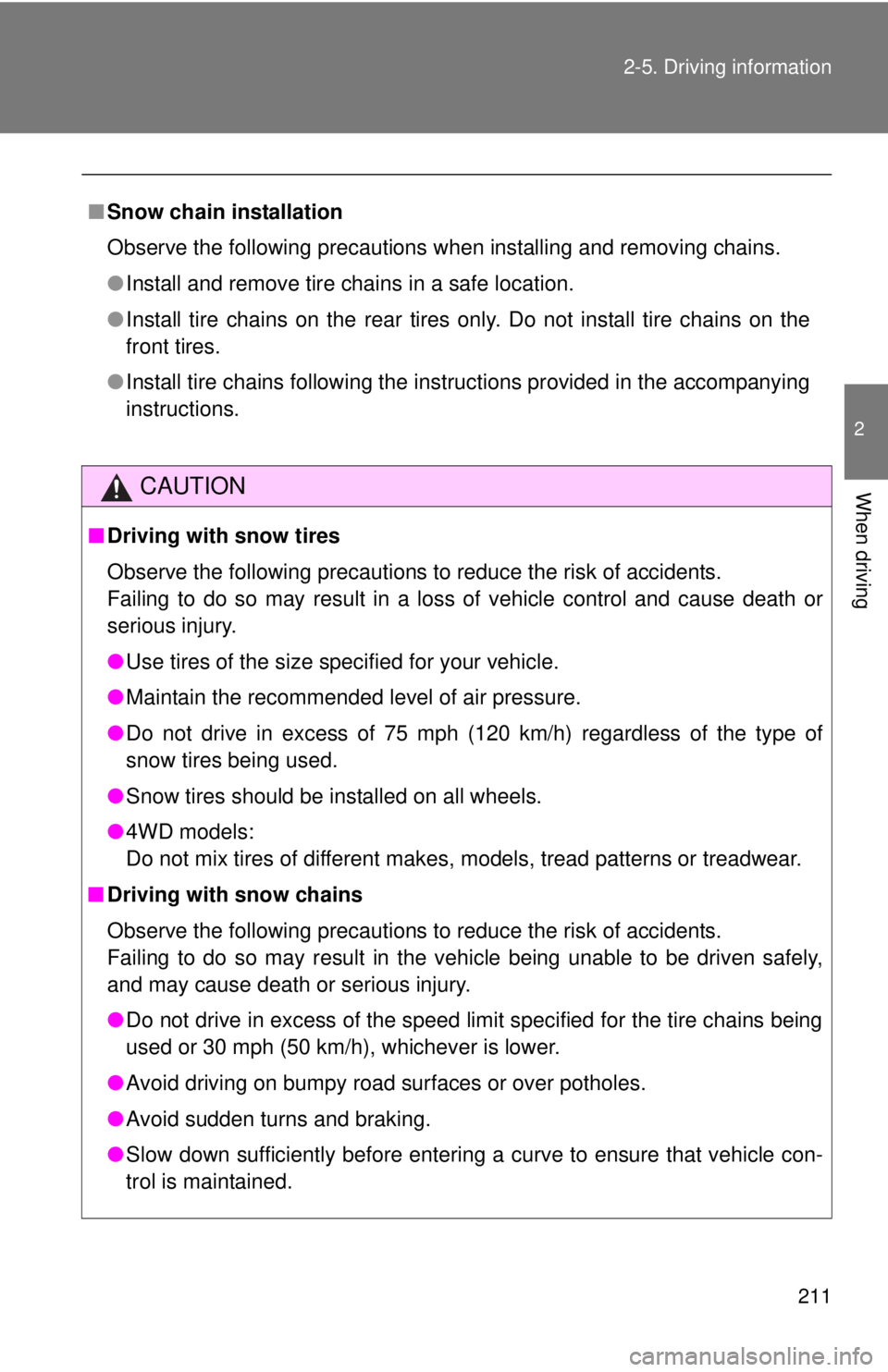
211 2-5. Driving information
2
When driving
■Snow chain installation
Observe the following precautions when installing and removing chains.
●Install and remove tire chains in a safe location.
●Install tire chains on the rear tires only. Do not install tire chains on the
front tires.
●Install tire chains following the instructions provided in the accompanying
instructions.
CAUTION
■Driving with snow tires
Observe the following precautions to reduce the risk of accidents.
Failing to do so may result in a loss of vehicle control and cause death or
serious injury.
●Use tires of the size specified for your vehicle.
●Maintain the recommended level of air pressure.
●Do not drive in excess of 75 mph (120 km/h) regardless of the type of
snow tires being used.
●Snow tires should be installed on all wheels.
●4WD models:
Do not mix tires of different makes, models, tread patterns or treadwear.
■Driving with snow chains
Observe the following precautions to reduce the risk of accidents.
Failing to do so may result in the vehicle being unable to be driven safely,
and may cause death or serious injury.
●Do not drive in excess of the speed limit specified for the tire chains being
used or 30 mph (50 km/h), whichever is lower.
●Avoid driving on bumpy road surfaces or over potholes.
●Avoid sudden turns and braking.
●Slow down sufficiently before entering a curve to ensure that vehicle con-
trol is maintained.
Page 212 of 532
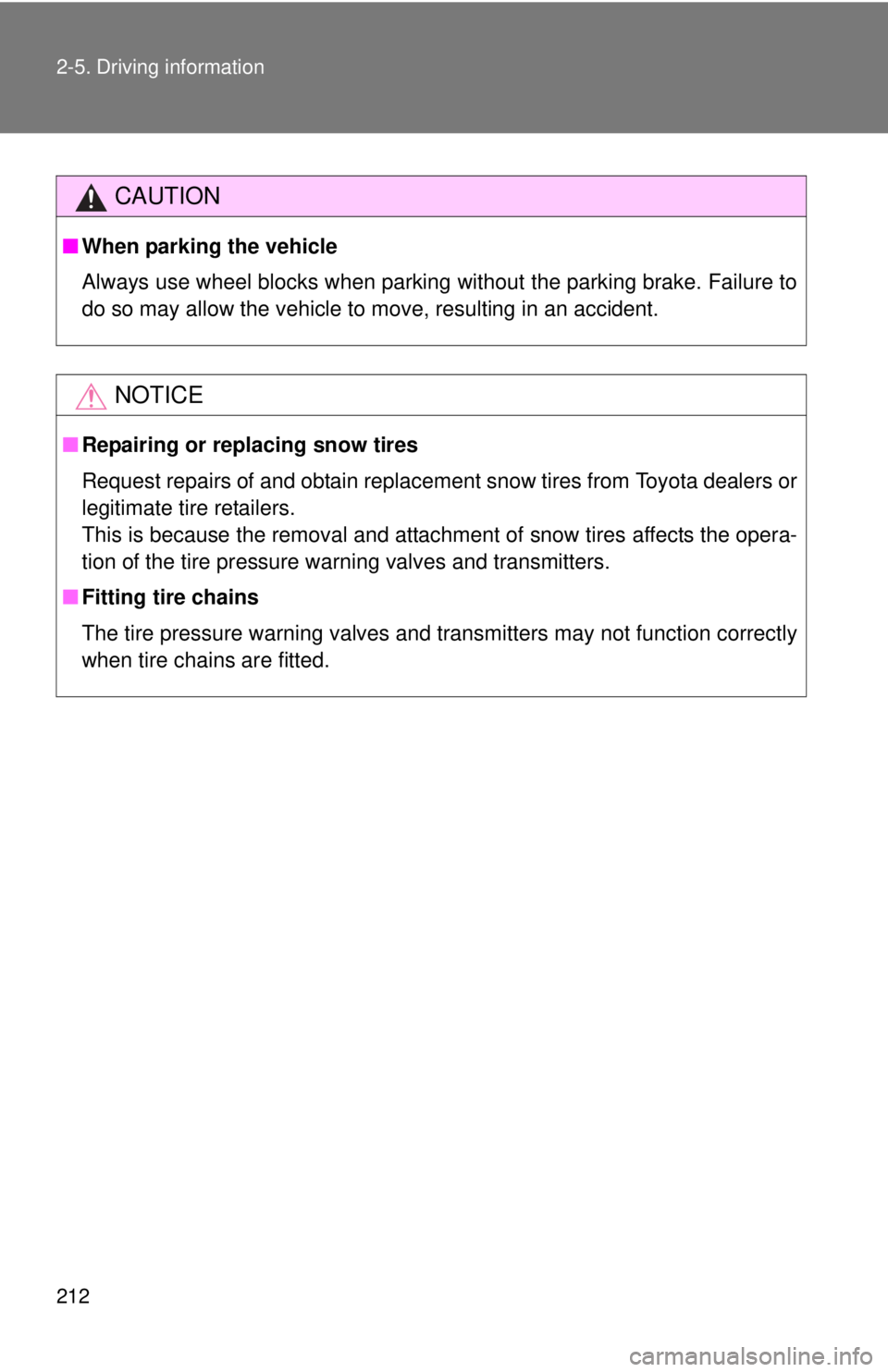
212 2-5. Driving information
CAUTION
■When parking the vehicle
Always use wheel blocks when parking without the parking brake. Failure to
do so may allow the vehicle to move, resulting in an accident.
NOTICE
■Repairing or replacing snow tires
Request repairs of and obtain replacement snow tires from Toyota dealers or
legitimate tire retailers.
This is because the removal and attachment of snow tires affects the opera-
tion of the tire pressure warning valves and transmitters.
■Fitting tire chains
The tire pressure warning valves and transmitters may not function correctly
when tire chains are fitted.
Page 213 of 532
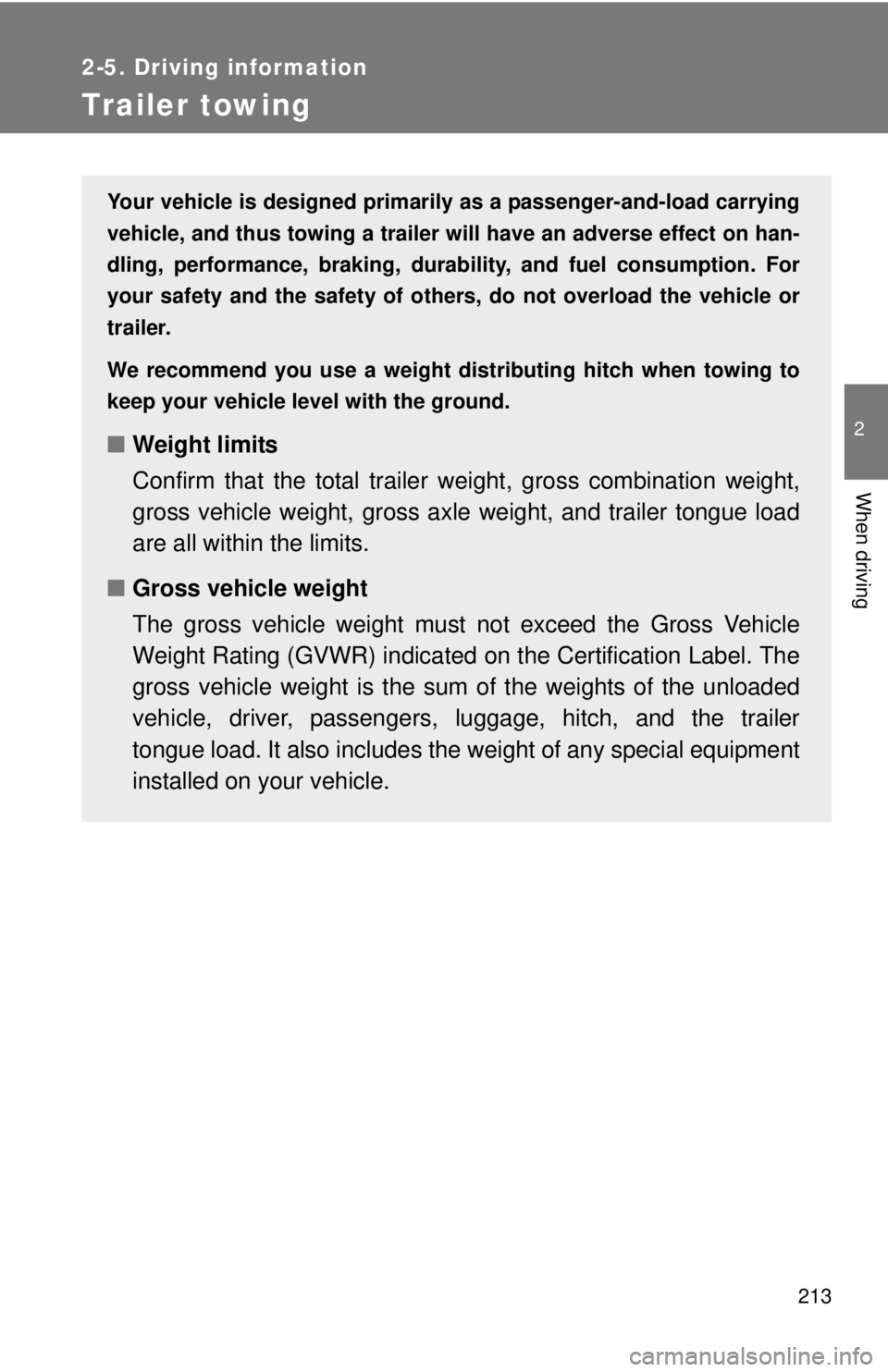
213
2-5. Driving information
2
When driving
Trailer towing
Your vehicle is designed primarily as a passenger-and-load carrying
vehicle, and thus towing a trailer will have an adverse effect on han-
dling, performance, braking, durability, and fuel consumption. For
your safety and the safety of others, do not overload the vehicle or
trailer.
We recommend you use a weight distributing hitch when towing to
keep your vehicle level with the ground.
■Weight limits
Confirm that the total trailer weight, gross combination weight,
gross vehicle weight, gross axle weight, and trailer tongue load
are all within the limits.
■Gross vehicle weight
The gross vehicle weight must not exceed the Gross Vehicle
Weight Rating (GVWR) indicated on the Certification Label. The
gross vehicle weight is the sum of the weights of the unloaded
vehicle, driver, passengers, luggage, hitch, and the trailer
tongue load. It also includes the weight of any special equipment
installed on your vehicle.
Page 214 of 532
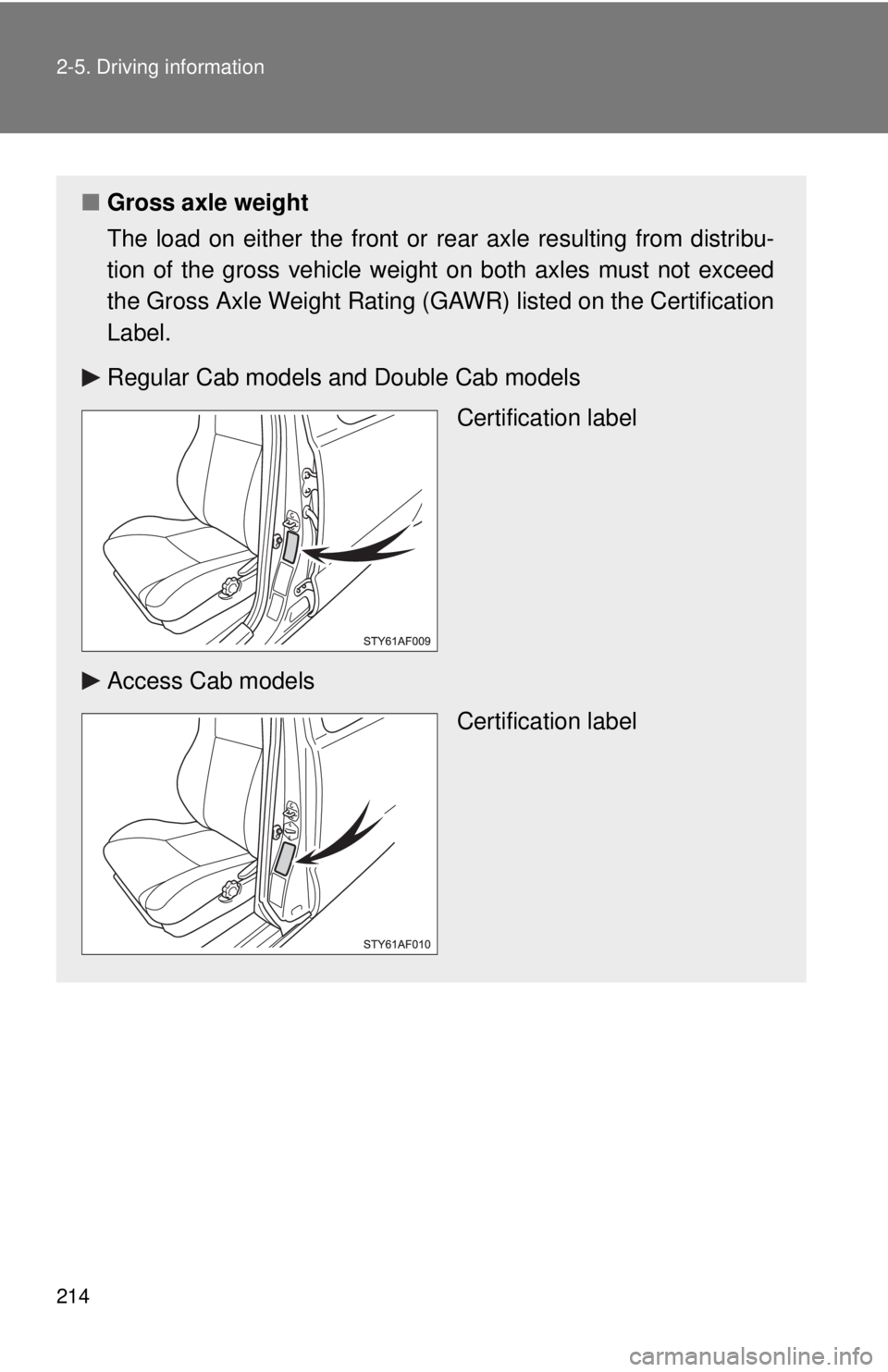
214 2-5. Driving information
■Gross axle weight
The load on either the front or rear axle resulting from distribu-
tion of the gross vehicle weight on both axles must not exceed
the Gross Axle Weight Rating (GAWR) listed on the Certification
Label.
Regular Cab models and Double Cab models
Certification label
Access Cab models
Certification label
Page 215 of 532
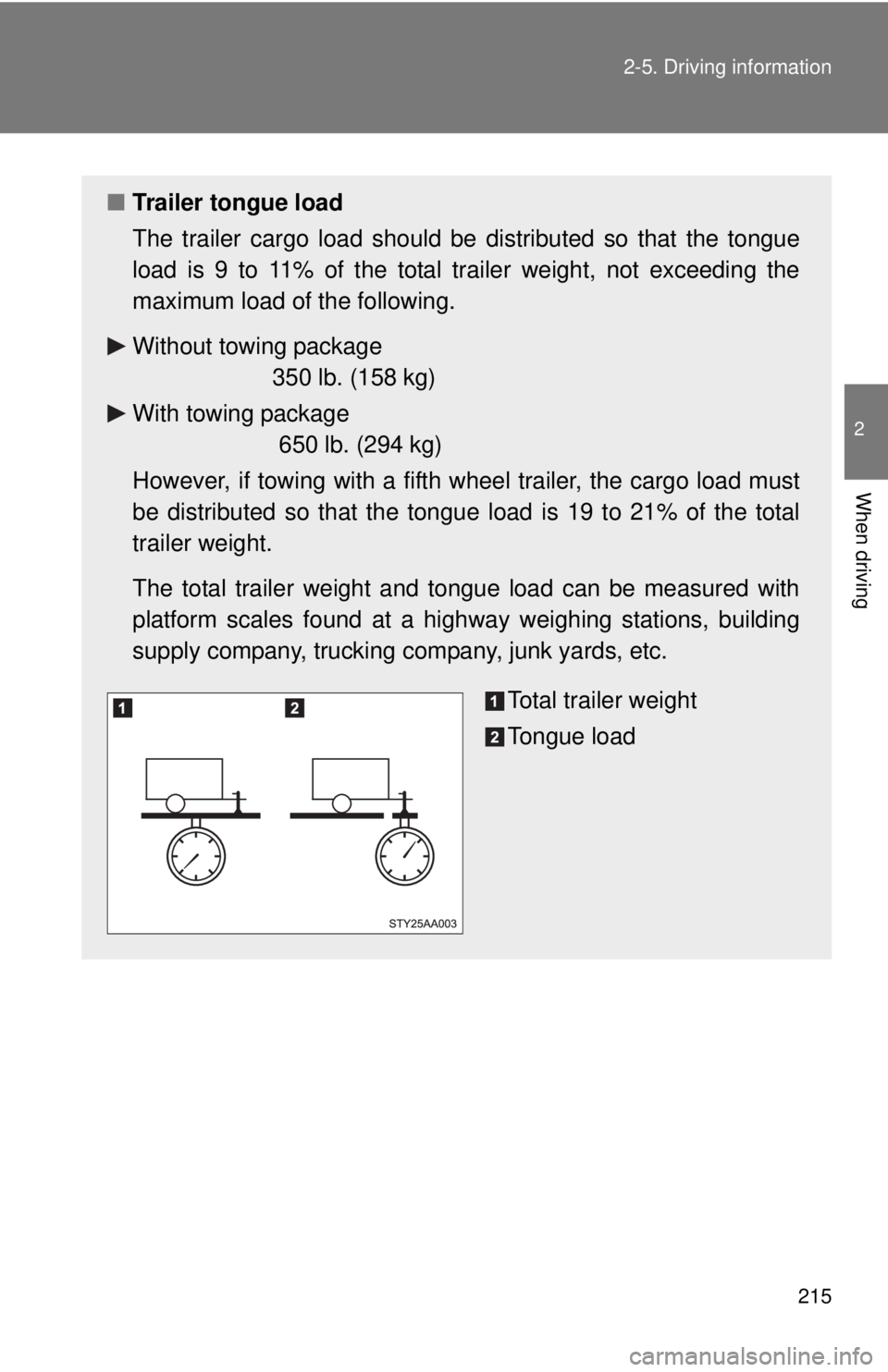
215 2-5. Driving information
2
When driving
■Trailer tongue load
The trailer cargo load should be distributed so that the tongue
load is 9 to 11% of the total trailer weight, not exceeding the
maximum load of the following.
Without towing package
350 lb. (158 kg)
With towing package
650 lb. (294 kg)
However, if towing with a fifth wheel trailer, the cargo load must
be distributed so that the tongue load is 19 to 21% of the total
trailer weight.
The total trailer weight and tongue load can be measured with
platform scales found at a highway weighing stations, building
supply company, trucking company, junk yards, etc.
Total trailer weight
Tongue load
Page 216 of 532

216 2-5. Driving information
Towing a trailer
Consult your Toyota dealer for further information about additional
requirements such as a towing kits, etc.
Hitch and tow hitch receiver
■Hitch
Trailer hitch assemblies have different weight capacities estab-
lished by the hitch manufacturer. Even though the vehicle may be
rated for towing a higher weight, the operator must never exceed
the maximum weight rating specified for the trailer hitch.
Page 217 of 532
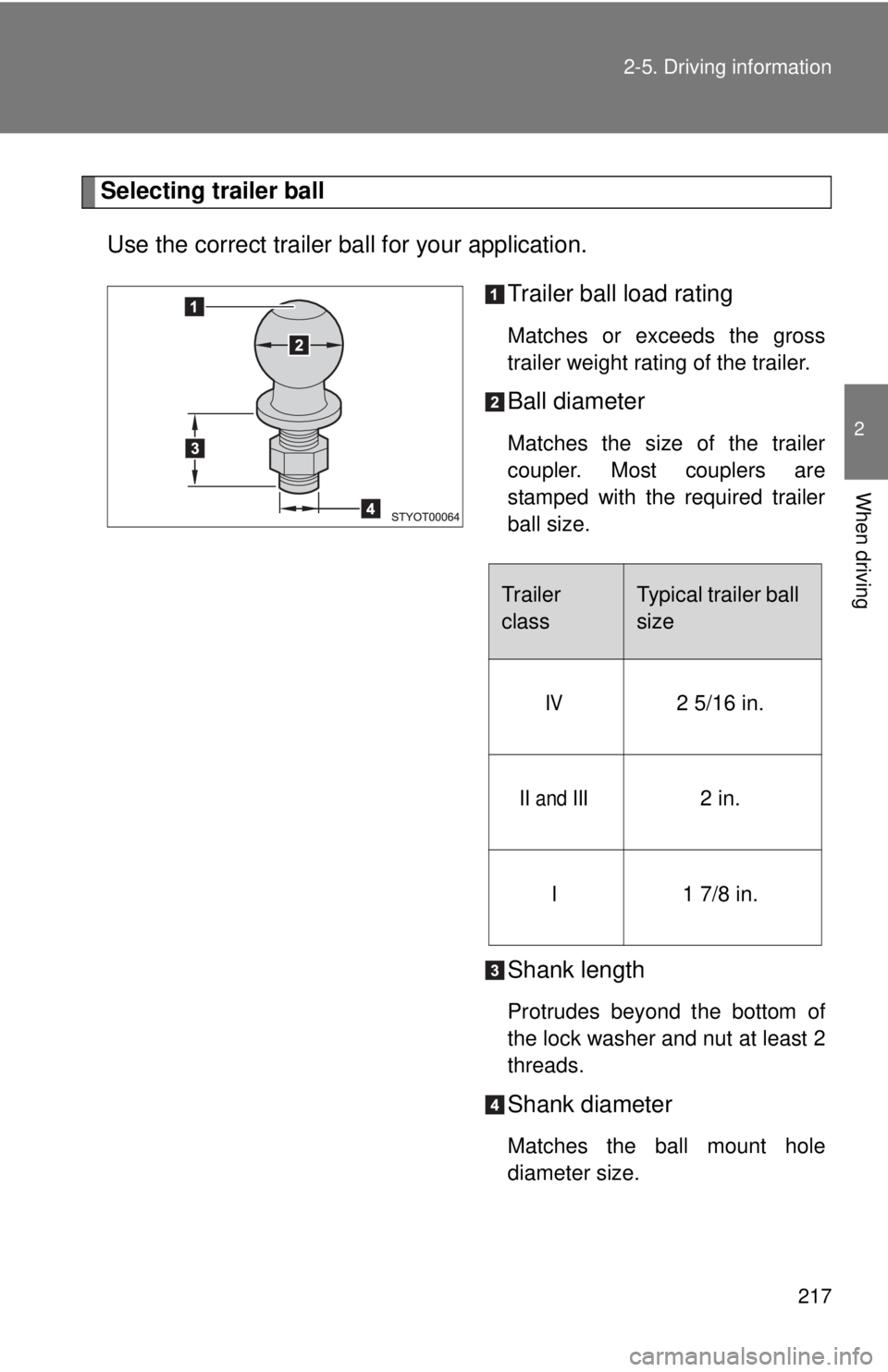
217 2-5. Driving information
2
When driving
Selecting trailer ball
Use the correct trailer ball for your application.
Trailer ball load rating
Matches or exceeds the gross
trailer weight rating of the trailer.
Ball diameter
Matches the size of the trailer
coupler. Most couplers are
stamped with the required trailer
ball size.
Shank length
Protrudes beyond the bottom of
the lock washer and nut at least 2
threads.
Shank diameter
Matches the ball mount hole
diameter size.
Trailer
classTypical trailer ball
size
IV2 5/16 in.
II and III2 in.
I1 7/8 in.
Page 218 of 532
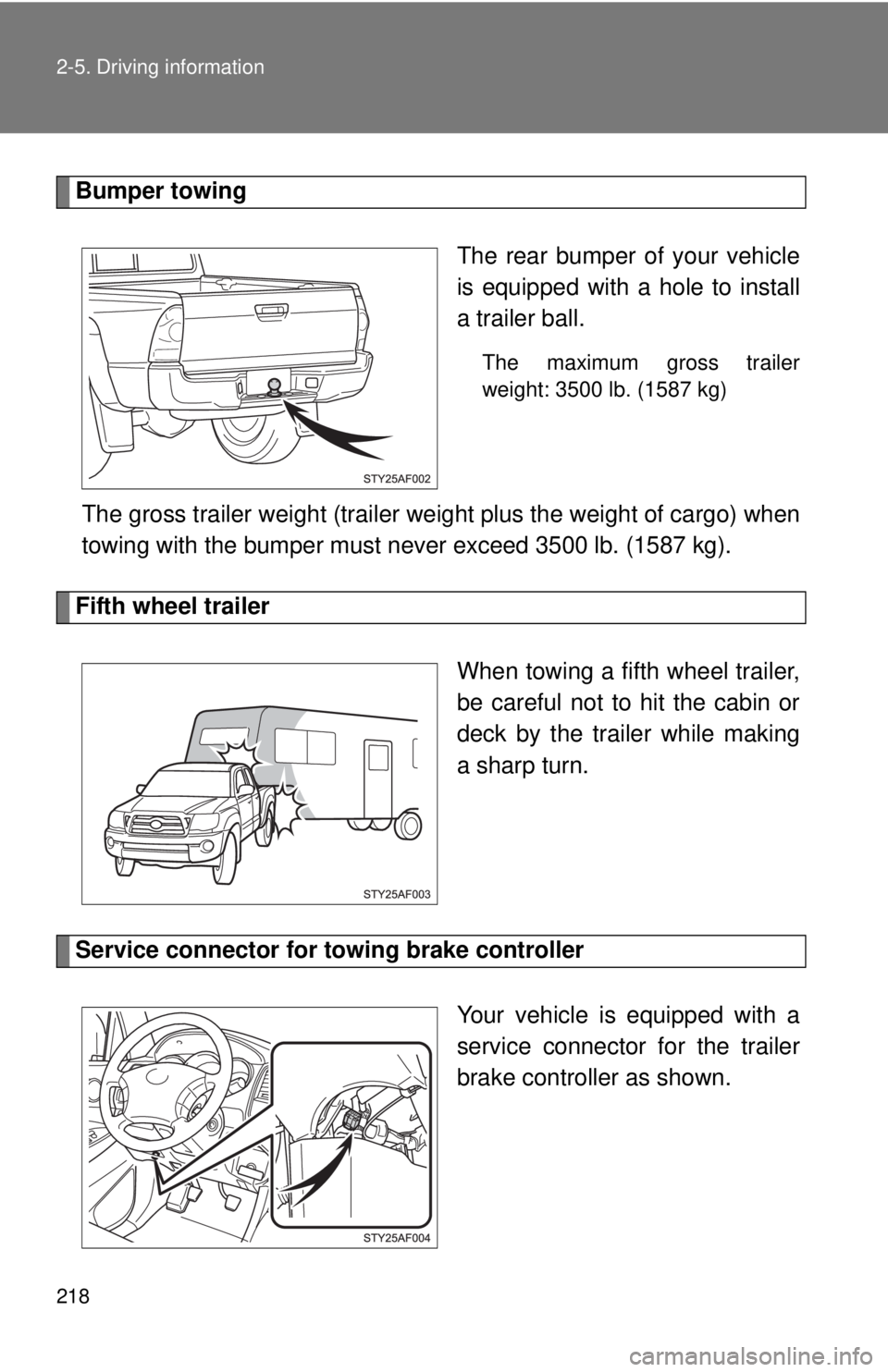
218 2-5. Driving information
Bumper towing
The rear bumper of your vehicle
is equipped with a hole to install
a trailer ball.
The maximum gross trailer
weight: 3500 lb. (1587 kg)
The gross trailer weight (trailer weight plus the weight of cargo) when
towing with the bumper must never exceed 3500 lb. (1587 kg).
Fifth wheel trailer
When towing a fifth wheel trailer,
be careful not to hit the cabin or
deck by the trailer while making
a sharp turn.
Service connector for towing brake controller
Your vehicle is equipped with a
service connector for the trailer
brake controller as shown.
Page 219 of 532
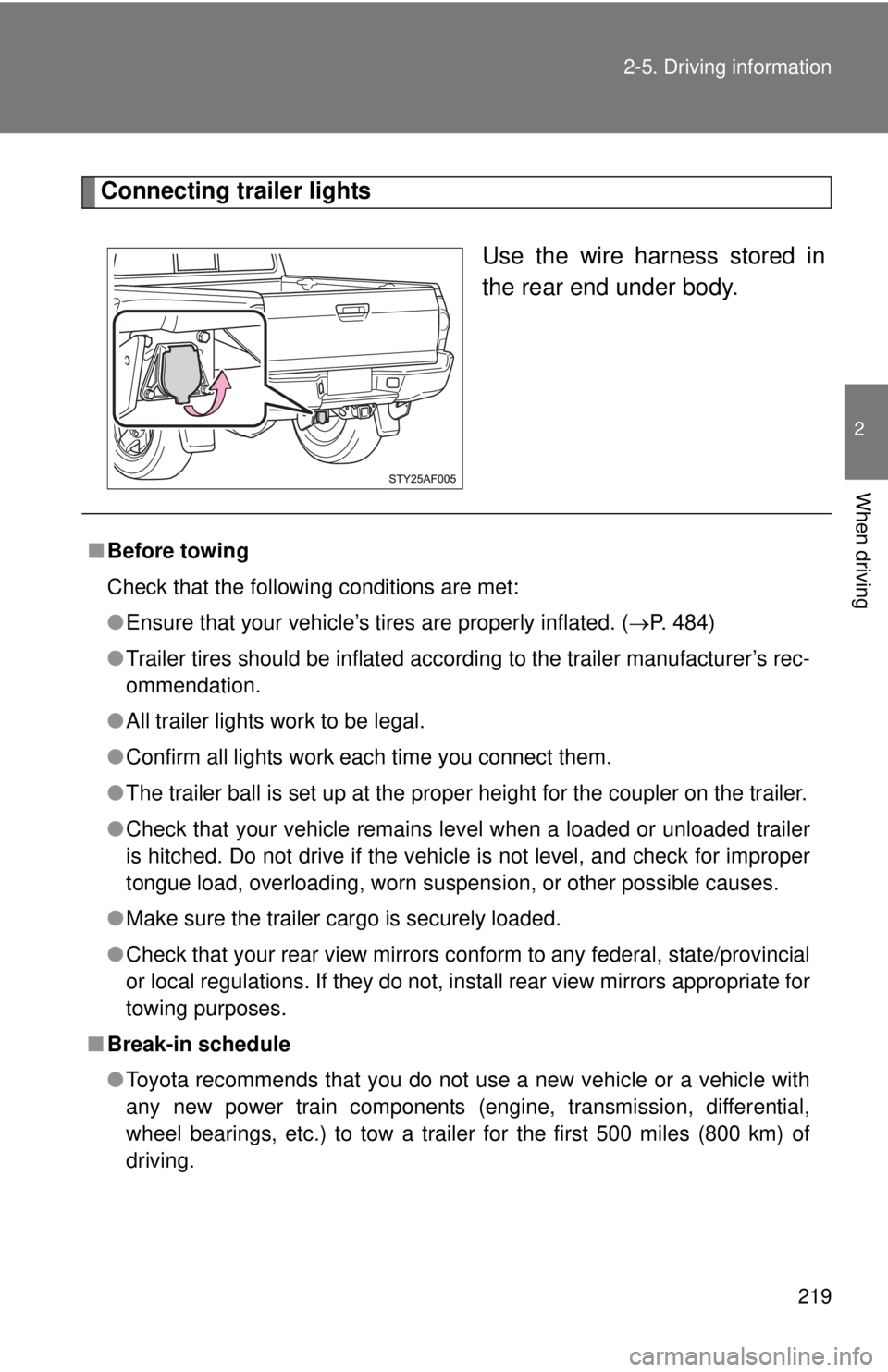
219 2-5. Driving information
2
When driving
Connecting trailer lights
Use the wire harness stored in
the rear end under body.
■Before towing
Check that the following conditions are met:
●Ensure that your vehicle’s tires are properly inflated. (P. 484)
●Trailer tires should be inflated according to the trailer manufacturer’s rec-
ommendation.
●All trailer lights work to be legal.
●Confirm all lights work each time you connect them.
●The trailer ball is set up at the proper height for the coupler on the trailer.
●Check that your vehicle remains level when a loaded or unloaded trailer
is hitched. Do not drive if the vehicle is not level, and check for improper
tongue load, overloading, worn suspension, or other possible causes.
●Make sure the trailer cargo is securely loaded.
●Check that your rear view mirrors conform to any federal, state/provincial
or local regulations. If they do not, install rear view mirrors appropriate for
towing purposes.
■Break-in schedule
●Toyota recommends that you do not use a new vehicle or a vehicle with
any new power train components (engine, transmission, differential,
wheel bearings, etc.) to tow a trailer for the first 500 miles (800 km) of
driving.
Page 220 of 532
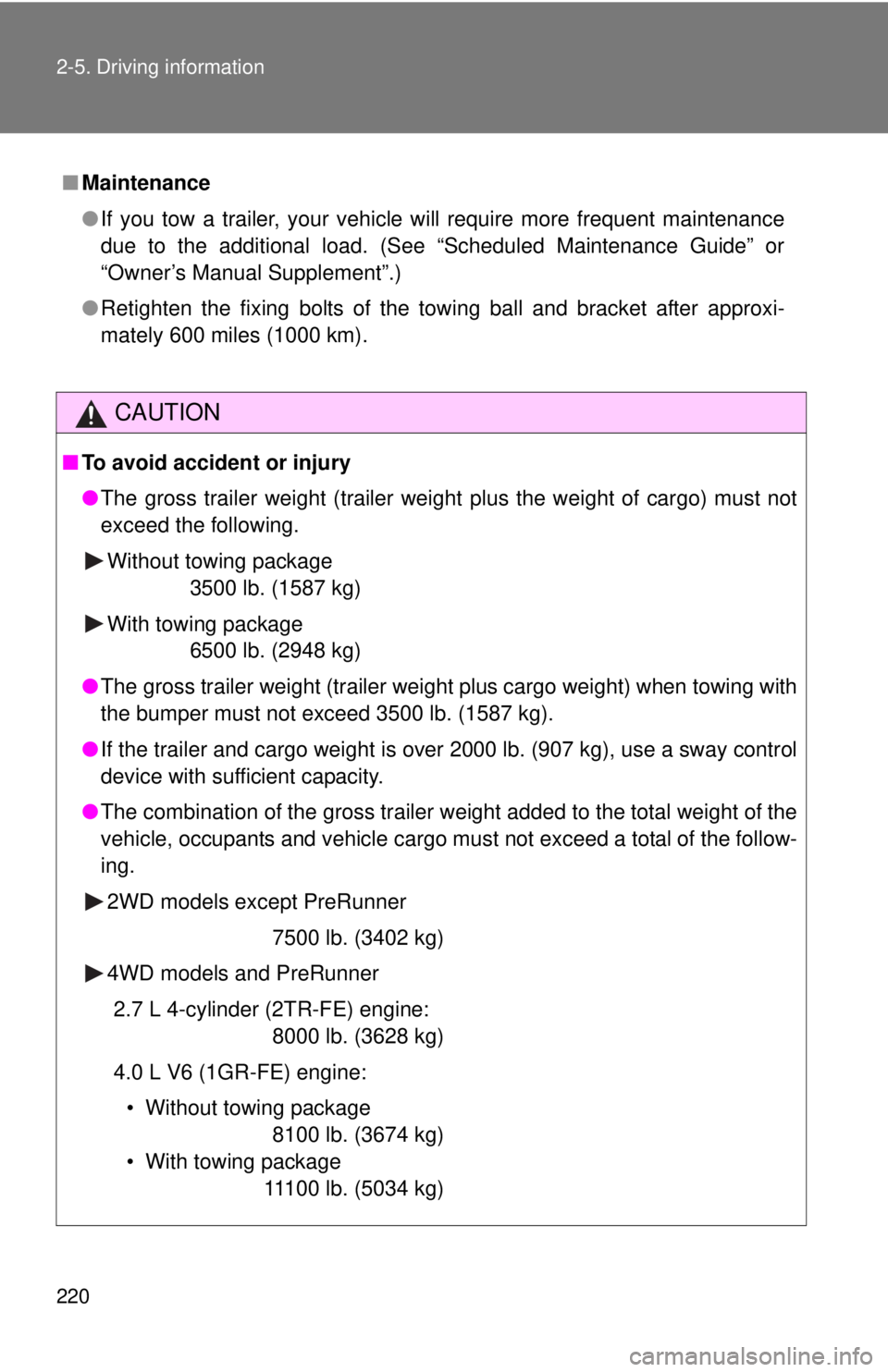
220 2-5. Driving information
■Maintenance
●If you tow a trailer, your vehicle will require more frequent maintenance
due to the additional load. (See “Scheduled Maintenance Guide” or
“Owner’s Manual Supplement”.)
●Retighten the fixing bolts of the towing ball and bracket after approxi-
mately 600 miles (1000 km).
CAUTION
■To avoid accident or injury
●The gross trailer weight (trailer weight plus the weight of cargo) must not
exceed the following.
Without towing package
3500 lb. (1587 kg)
With towing package
6500 lb. (2948 kg)
●The gross trailer weight (trailer weight plus cargo weight) when towing with
the bumper must not exceed 3500 lb. (1587 kg).
●If the trailer and cargo weight is over 2000 lb. (907 kg), use a sway control
device with sufficient capacity.
●The combination of the gross trailer weight added to the total weight of the
vehicle, occupants and vehicle cargo must not exceed a total of the follow-
ing.
2WD models except PreRunner
7500 lb. (3402 kg)
4WD models and PreRunner
2.7 L 4-cylinder (2TR-FE) engine:
8000 lb. (3628 kg)
4.0 L V6 (1GR-FE) engine:
• Without towing package
8100 lb. (3674 kg)
• With towing package
11100 lb. (5034 kg)